Peseta: Difference between revisions
Tag: 2017 source edit |
mNo edit summary Tag: 2017 source edit |
||
| (15 intermediate revisions by the same user not shown) | |||
| Line 1: | Line 1: | ||
{{Infobox currency | {{Infobox currency | ||
| currency_name_in_local = Pensum | | currency_name_in_local = Pensum Castraedilice <small>([[Classical Latin|Latin]])</small><br>Peseta Castadillano <small>([[Pelaxian language|Pelaxian]])</small><br>Peseitau Kastetien <small>([[Brenadine Tainean|Reform Tainean]])</small> | ||
| image_1 = | | image_1 = | ||
| image_title_1 = | | image_title_1 = | ||
| image_2 = | | image_2 = | ||
| image_title_2 = | | image_title_2 = | ||
| iso_code = | | iso_code = CSP | ||
| using_countries = {{flagcountry| | | using_countries = {{flagcountry|Castadilla}} | ||
| inflation_rate = | | inflation_rate = | ||
| inflation_source_date = | | inflation_source_date = | ||
| Line 23: | Line 23: | ||
| subunit_ratio_2 = {{frac|1|1000}} | | subunit_ratio_2 = {{frac|1|1000}} | ||
| subunit_name_2 = ''[[millavo]]'' | | subunit_name_2 = ''[[millavo]]'' | ||
| symbol = [[Peseta sign| | | symbol = [[Peseta sign|₱]] or Ps | ||
| symbol_subunit_1 = ¢ | | symbol_subunit_1 = ¢ | ||
| symbol_subunit_2 = ₥ | | symbol_subunit_2 = ₥ | ||
| frequently_used_coins = 5¢, 10¢, 25¢, | | frequently_used_coins = 5¢, 10¢, 25¢, ₱1, ₱2 | ||
| rarely_used_coins = 1₥, 2₥, 5₥, 10₥, 25₥, 50₥ (collectables only), 1¢, 50¢, ₽5 (still in circulation) | | rarely_used_coins = 1₥, 2₥, 5₥, 10₥, 25₥, 50₥ (collectables only), 1¢, 50¢, ₽5 (still in circulation) | ||
| frequently_used_banknotes = [[ | | frequently_used_banknotes = [[Castadillaan 1-peso note|₱1]], [[Castadillaan 5-peso note|₱5]], [[Castadillaan 10-peso note|₽10]], [[Castadillaan 20-peso note|₱20]], [[Castadillaan 50-peso note|₱50]] | ||
| rarely_used_banknotes = [[ | | rarely_used_banknotes = [[Castadillaan 100-peso note|₱100]], [[Castadillaan 1000-peso note|₱1,000]] | ||
| issuing_authority = [[Bank of | | issuing_authority = [[Bank of Castadilla]] | ||
| issuing_authority_website = | | issuing_authority_website = | ||
| printer = [[Bank of | | printer = [[Bank of Castadilla]] | ||
| printer_website = | | printer_website = | ||
| mint = [[Imperial Vallosi Mint]] | | mint = [[Imperial Vallosi Mint]] | ||
| mint_website = | | mint_website = | ||
}} | }} | ||
The '''peseta''' ([[Classical Latin|Latin]]: ''pensa''; [[Brenadine Tainean|Reform Tainean]]: ''peseitau''; {{wp|currency sign|sign}}: ''' | The '''peseta''' ([[Classical Latin|Latin]]: ''pensa''; [[Brenadine Tainean|Reform Tainean]]: ''peseitau''; {{wp|currency sign|sign}}: '''₱'''; {{wp|ISO 4217|code}}: '''CSP''') is the currency of [[Castadilla]] and the preceding [[Delepasian Commonwealth]] since 1976. The modern peseta currency has its origins in the [[Latinic people|Latin]] realms of [[Vallos]] where their currencies were dubbed ''pensum'', which is currently used as the official name of the peseta. | ||
The current {{wp|ISO 4217}} code for the peseta is '' | The current {{wp|ISO 4217}} code for the peseta is ''CTP''; prior to the [[Velvet Revolution]], the code ''DEP'' was used. The peseta's main unit is the [[peso (currency)|peso]], which is divided into 100 ''centavos'' (Latin: ''centesismo''; Reform Tainean: ''centimes''), which in turn is divided into 100 ''millavos'' (Latin: ''millesismo''; Reform Tainean: ''millimes''); the latter, however, is only ever seen in proof sets and as collectors' items instead of regular circulation. As of 7 July 2032, the peseta's exchange rate was ₱56.76 per [[Taler]], ₱57.33 per [[Aureus]], and ₱53.55 per [[Saar]]. | ||
==Overview== | ==Overview== | ||
===Decimal units=== | ===Decimal units=== | ||
Ever since independence from [[Pelaxia]] in the 1850s, the states that would one day become | Ever since independence from [[Pelaxia]] in the 1850s, the states that would one day become Castadilla opted for a {{wp|decimal system}} of units to go with the unit peso, as follows: the '''millavo''', one-thousandth of a peso; the '''centavo''', one-hundredth of a peso; the '''décimo''', one-tenth of a peso; and the '''duro''', ten pesos. The current relevance of these units are as follows: | ||
*Only the '''[[centavo]]''' (¢) sees everyday use as the division of the peso. | *Only the '''[[centavo]]''' (¢) sees everyday use as the division of the peso. | ||
*The '''[[decimo ( | *The '''[[decimo (Castadillaan coin)|decimo]]''' is currently the name of the 10-centavo piece. | ||
*The '''[[millavo]]''' (₥) is relatively unknown in current use, asides from avid coin collectors. Historically, the millavo was used in matters of {{wp|sales taxes}} and {{wp|gasoline prices}} up until the 1980s. | *The '''[[millavo]]''' (₥) is relatively unknown in current use, asides from avid coin collectors. Historically, the millavo was used in matters of {{wp|sales taxes}} and {{wp|gasoline prices}} up until the 1980s. | ||
*The '''[[duro ( | *The '''[[duro (Castadillaan coin)|duro]]''' is colloquially used by the general public to refer to any amounts of peseta coinage that adds up to ten pesos. | ||
When currently issued in circulation, denominations less than or equal to five pesos are emitted as [[Coins of the | When currently issued in circulation, denominations less than or equal to five pesos are emitted as [[Coins of the Castadillaan peseta|coins]], while denominations greater than or equal to a peso are emitted as [[Banknotes of the Castadillaan peseta|banknotes]], disregarding bullion or commemorative {{wp|gold coin|gold}}, {{wp|silver coin|silver}}, {{wp|platinum coin|platinum}}, and {{wp|paladium coin|paladium coins}} valued up to ₽100 or higher. | ||
===Etymology=== | ===Etymology=== | ||
The name was derived from the term ''pensum'', a Latin word meaning "weight" that was originally used in reference to the amount of wool a slave was given to spin for the day. This would soon find use as the name of the currencies of the various [[Latinic people|Latin]] realms on [[Vallos]] by the time of [[Pelaxian colonization of Vallos|Pelaxian colonisation]]. The Pelaxian settlers, now known as [[Delepasians]], would wind up deriving two words from the word ''pensum'', those being ''peso'', used to refer to the main unit of coinage, and ''peseta'', used to refer to the coinage in general, coming from the plural ''pensa''. | The name was derived from the term ''pensum'', a Latin word meaning "weight" that was originally used in reference to the amount of wool a slave was given to spin for the day. This would soon find use as the name of the currencies of the various [[Latinic people|Latin]] realms on [[Vallos]] by the time of [[Pelaxian colonization of Vallos|Pelaxian colonisation]]. The Pelaxian settlers, now known as [[Delepasians]], would wind up deriving two words from the word ''pensum'', those being ''peso'', used to refer to the main unit of coinage, and ''peseta'', used to refer to the coinage in general, coming from the plural ''pensa''. | ||
===Peseta sign=== | ===Peseta sign=== | ||
{{main|Peseta sign}} | {{main|Peseta sign}} | ||
The symbol [[Peseta sign| | The symbol [[Peseta sign|₱]], usually written before the numerical amount, is used for the peseta. The sign was the result of an evolution of the {{wp|scribal abbreviation}} '''''p<sup>s</sup>''''' for the peso. The '''''p''''' and the '''''s''''' eventually came to be written over each other giving rise to '''''₱'''''. | ||
Another popular explanation is that it is derived from [[Pelaxia]] and [[Sarpedon]], respectively the name of | Another popular explanation is that it is derived from [[Pelaxia]] and [[Sarpedon]], respectively the name of Castadilla's colonial power and home continent. This theory suggests that the peseta sign was formed from the capital letters '''''P''''' and '''''S''''' written or printed one on top of the other, with the '''''S''''' soon becoming a dash '''''-''''' in order to save time, thus birthing the '''''₱''''' symbol. | ||
==History== | ==History== | ||
===Latin currencies=== | ===Latin currencies=== | ||
| Line 62: | Line 62: | ||
===Pesetas, pre-1976=== | ===Pesetas, pre-1976=== | ||
===Peseta, Delepasia=== | ===Peseta, Delepasia=== | ||
===Peseta, | ===Peseta, Castadilla=== | ||
==Coins== | ==Coins== | ||
===Delepasian peseta coins=== | ===Delepasian peseta coins=== | ||
====Series 1977==== | ====Series 1977==== | ||
====Series 1990==== | ====Series 1990==== | ||
=== | ===Castadillaan peseta coins=== | ||
====Series 2000==== | ====Series 2000==== | ||
====Series 2026==== | ====Series 2026==== | ||
| Line 85: | Line 85: | ||
| 1 centavo | | 1 centavo | ||
| Copper | | Copper | ||
|rowspan=8|[[Maximilian I of | |rowspan=8|[[Maximilian I of Castadilla|Maximilian I]] | ||
| {{wp|Fasces}} | | {{wp|Fasces}} | ||
| 2026 series <small>''(Current)''</small> | | 2026 series <small>''(Current)''</small> | ||
|- | |- | ||
| [[File:5 Centavos RPM 2026 Obv.png|frameless|150px|center]] | | [[File:5 Centavos RPM 2026 Obv.png|frameless|150px|center]] | ||
| [[File: | | [[File:5 Centavos RPM 2026 Rev.png|frameless|150px|center]] | ||
| 5 centavos | | 5 centavos | ||
| Silver | | Silver | ||
| | | [[Emblem of Castadilla]] | ||
| 2026 series <small>''(Current)''</small> | | 2026 series <small>''(Current)''</small> | ||
|- | |- | ||
| [[File:10 Centavos RPM 2026 Obv.png|frameless|150px|center]] | | [[File:10 Centavos RPM 2026 Obv.png|frameless|150px|center]] | ||
| [[File: | | [[File:10 Centavos RPM 2026 Rev.png|frameless|150px|center]] | ||
| 10 centavos | | 10 centavos | ||
| Silver | | Silver | ||
| | | Two ''{{wp|ara macao}}'' in flight | ||
| 2026 series <small>''(Current)''</small> | | 2026 series <small>''(Current)''</small> | ||
|- | |- | ||
| Line 121: | Line 121: | ||
| 1 peso | | 1 peso | ||
| Gold, silver | | Gold, silver | ||
| [[Imperial coat of arms of | | [[Imperial coat of arms of Castadilla|Lesser Imperial Coat of Arms]] | ||
| 2026 series <small>''(Current)''</small> | | 2026 series <small>''(Current)''</small> | ||
|- | |- | ||
| Line 135: | Line 135: | ||
| 5 pesos | | 5 pesos | ||
| Gold | | Gold | ||
| [[Imperial Crown of | | [[Imperial Crown of Castadilla]] | ||
| 2026 series <small>''(Current)''</small> | | 2026 series <small>''(Current)''</small> | ||
|} | |} | ||
| Line 145: | Line 145: | ||
====Series B==== | ====Series B==== | ||
====Series C==== | ====Series C==== | ||
=== | ===Castadillaan peseta=== | ||
====Series D==== | ====Series D==== | ||
====Series E==== | ====Series E==== | ||
| Line 153: | Line 153: | ||
==See also== | ==See also== | ||
[[Category:Currency]] | [[Category:Currency]] | ||
[[Category: | [[Category:Castadilla]] | ||
[[Category:IXWB]] | |||
Latest revision as of 23:56, 28 October 2024
| Peseta | |
|---|---|
| Pensum Castraedilice (Latin) Peseta Castadillano (Pelaxian) Peseitau Kastetien (Reform Tainean) | |
| ISO 4217 | |
| Code | CSP |
| Denominations | |
| Superunit | |
| 1 | peso |
| 10 | duro |
| 100 | talego |
| 1,000 | kilo |
| Subunit | |
| 1⁄100 | centavo |
| 1⁄1000 | millavo This is so small that it is only ever minted for proof sets and collectables |
| Symbol | ₱ or Ps |
| centavo | ¢ |
| millavo | ₥ |
| Banknotes | |
| Freq. used | ₱1, ₱5, ₽10, ₱20, ₱50 |
| Rarely used | ₱100, ₱1,000 |
| Coins | |
| Freq. used | 5¢, 10¢, 25¢, ₱1, ₱2 |
| Rarely used | 1₥, 2₥, 5₥, 10₥, 25₥, 50₥ (collectables only), 1¢, 50¢, ₽5 (still in circulation) |
| Demographics | |
| Date of introduction | 21 May 1977 |
| User(s) | |
| Issuance | |
| Central bank | Bank of Castadilla |
| Printer | Bank of Castadilla |
| Mint | Imperial Vallosi Mint |
The peseta (Latin: pensa; Reform Tainean: peseitau; sign: ₱; code: CSP) is the currency of Castadilla and the preceding Delepasian Commonwealth since 1976. The modern peseta currency has its origins in the Latin realms of Vallos where their currencies were dubbed pensum, which is currently used as the official name of the peseta.
The current ISO 4217 code for the peseta is CTP; prior to the Velvet Revolution, the code DEP was used. The peseta's main unit is the peso, which is divided into 100 centavos (Latin: centesismo; Reform Tainean: centimes), which in turn is divided into 100 millavos (Latin: millesismo; Reform Tainean: millimes); the latter, however, is only ever seen in proof sets and as collectors' items instead of regular circulation. As of 7 July 2032, the peseta's exchange rate was ₱56.76 per Taler, ₱57.33 per Aureus, and ₱53.55 per Saar.
Overview
Decimal units
Ever since independence from Pelaxia in the 1850s, the states that would one day become Castadilla opted for a decimal system of units to go with the unit peso, as follows: the millavo, one-thousandth of a peso; the centavo, one-hundredth of a peso; the décimo, one-tenth of a peso; and the duro, ten pesos. The current relevance of these units are as follows:
- Only the centavo (¢) sees everyday use as the division of the peso.
- The decimo is currently the name of the 10-centavo piece.
- The millavo (₥) is relatively unknown in current use, asides from avid coin collectors. Historically, the millavo was used in matters of sales taxes and gasoline prices up until the 1980s.
- The duro is colloquially used by the general public to refer to any amounts of peseta coinage that adds up to ten pesos.
When currently issued in circulation, denominations less than or equal to five pesos are emitted as coins, while denominations greater than or equal to a peso are emitted as banknotes, disregarding bullion or commemorative gold, silver, platinum, and paladium coins valued up to ₽100 or higher.
Etymology
The name was derived from the term pensum, a Latin word meaning "weight" that was originally used in reference to the amount of wool a slave was given to spin for the day. This would soon find use as the name of the currencies of the various Latin realms on Vallos by the time of Pelaxian colonisation. The Pelaxian settlers, now known as Delepasians, would wind up deriving two words from the word pensum, those being peso, used to refer to the main unit of coinage, and peseta, used to refer to the coinage in general, coming from the plural pensa.
Peseta sign
The symbol ₱, usually written before the numerical amount, is used for the peseta. The sign was the result of an evolution of the scribal abbreviation ps for the peso. The p and the s eventually came to be written over each other giving rise to ₱.
Another popular explanation is that it is derived from Pelaxia and Sarpedon, respectively the name of Castadilla's colonial power and home continent. This theory suggests that the peseta sign was formed from the capital letters P and S written or printed one on top of the other, with the S soon becoming a dash - in order to save time, thus birthing the ₱ symbol.
History
Latin currencies
Insert royalist Pelaxian currency name here
Pesetas, pre-1976
Peseta, Delepasia
Peseta, Castadilla
Coins
Delepasian peseta coins
Series 1977
Series 1990
Castadillaan peseta coins
Series 2000
Series 2026
| Obverse | Reverse | Value | Color | Obverse motif | Reverse motif | Current series or withdrawal date |
|---|---|---|---|---|---|---|
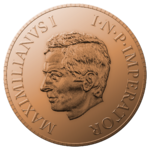 |
 |
1 centavo | Copper | Maximilian I | Fasces | 2026 series (Current) |
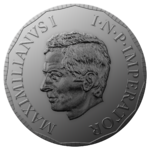 |
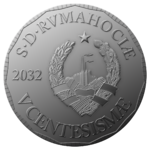 |
5 centavos | Silver | Emblem of Castadilla | 2026 series (Current) | |
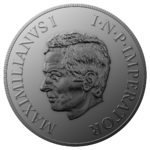 |
 |
10 centavos | Silver | Two ara macao in flight | 2026 series (Current) | |
 |
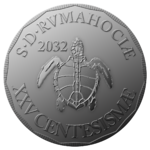 |
25 centavos | Silver | Caretta caretta | 2026 series (Current) | |
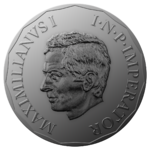 |
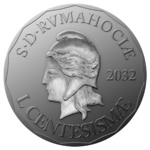 |
50 centavos | Silver | Juana-Maria | 2026 series (Current) | |
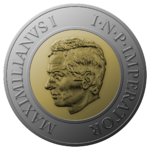 |
 |
1 peso | Gold, silver | Lesser Imperial Coat of Arms | 2026 series (Current) | |
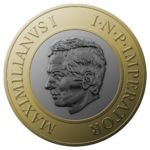 |
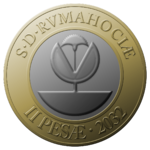 |
2 pesos | Silver, gold | Flower of the Revolution | 2026 series (Current) | |
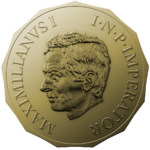 |
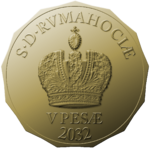 |
5 pesos | Gold | Imperial Crown of Castadilla | 2026 series (Current) |